New Stone Pro Hydraulic Chisel Machine Adds Diversity & Profits
Peter J. Marcucci
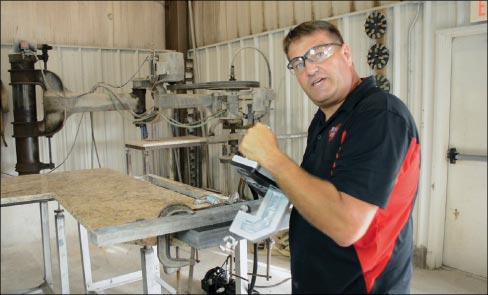 |
|
Above: Brad Winn demos the Stone Pro Hydraulic Chisel. |
|
Brandt explained, “Sometimes a chiseler leaves a sharp edge that can snag your clothes, so what we do is take our old worn-out polishing pads and lightly hit the high spots on the edge, leaving shiny spots where it hits. We call this edge ‘Chisel Ice’ because it shines the tips of the edge, gives it a beautiful distinctive look, and takes away any sharp spots.” |
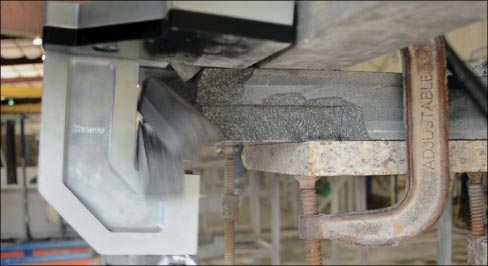 |
|
Above: The Hydraulic Chisel in action on a 6cm laminated edge. |
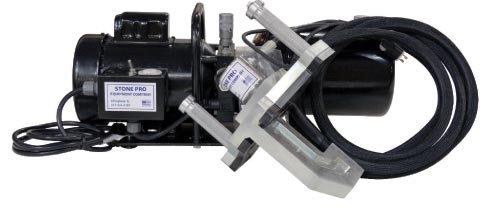 |
|
Above: The 10-foot hose on the hand-held unit allows quick access down the entire length of a full slab. Barry Brandt added, “If we do need to enhance the edge, we will use sealer, but only if necessary. That’s the beauty of a chiseled edge. It takes on a different color when it’s not polished, due to less light refraction. But either way, sealer or no sealer, you get a great contrast to the top, no matter what!” |
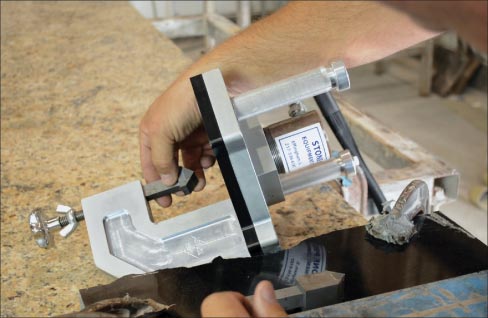 |
|
Above: The Hydraulic Chisel machine comes with a longer chisel for thinner material such as 2cm, and a shorter chisel for thicker material, up to 6cm. |
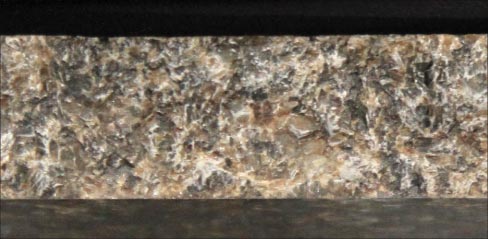 |
|
Above: Chisel Ice edge |
From small jobs to large, rustic to contemporary, those in search of the unique and charming often abandon the flat or rounded edge for the simple, chiseled look. The chiseled edge, used to adorn interior and exterior elements, continues to remain popular.
So ask yourself: am I set up to offer and produce this highly profitable edge? I mean really setup — not just with hammer and chisel, but with samples and a machine built for one thing — to safely and efficiently chisel large amounts of footage? No, you say?
Well, you should be set up, explains longtime fabricator and Stone Pro tool designer Barry Brandt. “Very few guys are good at rock-pitching stone. I can take a guy right off the street, who has never chiseled a piece in his life, and using our Hydraulic Stone Chisel, he will do a perfect job the first time.”
The amount of linear feet per hour depends on the user, explained Barry, while adding that you can easily do 60 linear feet per hour. “When chiseling by hand, you have to chisel from both sides, but with the Stone Pro Hydraulic Stone Chisel you don’t have to, which is a huge advantage.
“It doesn’t matter how thick the material is. It is just as fast though 2cm as 6cm, and it does a cleaner cut, making hammer and chisel old school. Nobody can do 60 feet by hand, then flip it over and do 60 feet again under one hour! I know, I’ve been there!”
According to Barry, the reason Stone Pro built this unit as hydraulic, is that it’s faster and more powerful when cutting through lamination. Previous mechanized chisels offered by Stone Pro and others were plagued with recoil, slow cyclic rate and couldn’t handle thicker, harder edges. Similar products worked very slowly because the hydraulic pump had to create pressure every cycle. Conversely, the Hydraulic Stone Chisel’s pump has constant pressure, so the cycle time is way faster and more powerful than anything on the market.
“These days a lot of people are working with 6cm laminated materials that contain quartz,” Barry continued. “They’re really difficult to split by hand. The Stone Pro Hydraulic Stone Chisel has no problem, because the chisel works using compression and is built more rigidly than similar products. Due to a very strong C-Frame design, the structural integrity of the chisel is engineered to withstand the pressures put on it. Other machines deflect a lot and people have issues with them, but the recoil of our machine is almost zero. This one factor causes less fatigue on material, because the two carbide chisels are biting, and the compression is outward toward the unit instead of inward toward the material.”
“All grain structures are different and all colors are different, but this machine doesn’t care because the chisels are sharp and line up with each other. So with opposing forces towards each other, you get a controlled chisel. When you’re working with hammer and chisel, you’re working with concussion and trying to direct the impact. This can cause the material to fracture and break where you don’t want it to. Even the most skilled fabricators can have corners blow off, and now you’ve just wasted material. What did that mistake cost you compared to the cost of our machine? We understand that there are some great craftsman out there, but this will make them a better craftsman with zero failure rate.”
User Friendly
The lightweight hand-held unit is fully adjustable from 2cm to 6cm, and it attaches to the hydraulic power module via two ten-foot long hoses, so there’s plenty of mobility to move along the largest countertops. It comes with 2 bottom chisels, one long and one short; both are 1 inch wide. The longer chisel is for thinner material such as 2cm, and the shorter is for thicker material, such as 6cm.
According to Barry, if you’re working with 3cm material, the rule of thumb is to chisel back 1.5cm. Doing so won’t leave a sawn edge in the middle. For 6cm material, simply move the cut back proportionally to 3cm. Running a test piece prior to beginning the actual countertop is also a rule of thumb he explained, adding that doing so can prevent the user from making a mistake. “Because each stone has different characteristics and therefore might chisel differently from a previous material, always, always chisel a test piece before running the actual job, just in case there is a difference.”
Excellent Against a Straight Edge, Super Slick When Free Handed
Barry continues: “Unlike our competitors that use 3-inch chisels, thinking it’s faster, our machine uses a 1-inch chisel. This gives the operator a lot of flexibility to get all the way around even a tight inside corner. In our shop, we’ll take a wax pencil and draw a line that we can follow around. Along straight edges you can either use a straight edge as a guide or free-hand it depending on what type of look the customer wants.”
Build It and They Will Come
Packed to the gills with outstanding features, the Stone Pro Hydraulic Stone Chisel also comes with technical support from actual users, said Barry. “If someone has any technical questions, we have support for them. We are fabricators, too, and won’t bring a product to market unless it’s tested in real situations and bullet-proofed. As with all of our tools, it’s tried and true and totally made in America.”
So what are you waiting for? Purchase the machine — make some samples — and sell, sell, sell more stone!
For additional information call your Braxton-Bragg representative at 800-575-4401. You should definitely go to www.braxton bragg.com and watch the video.